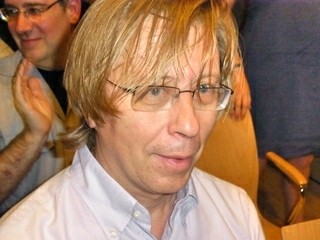|
Back
Nightmare on 57th Street New York
Isaac Stern Auditorium, Carnegie Hall
10/06/2014 -
Robert Schumann: Symphony No. 4 in D Minor, Opus 120 (Original version, 1841) – Symphony No. 3 in E-flat Major, Opus 97 (“Rhenish”)
Georg Friedrich Haas: dark dreams (US Premiere)
Berlin Philharmonic Orchestra, Sir Simon Rattle (Music Director and Conductor)

G. F. Haas (© Coco T. Dog)
Whenever New York premieres a work by Georg Friedrich Haas, knowing audiences have obsessive expectations. The composer, who has composed music for everything from Swiss Alpinehorns to the unlikely concerto for accordion, viola and orchestra, is more than an innovator. He is supposedly a “spectralist”, but this is a simplified category.
More apt is that Mr. Haas experiments with sounds and silence and darkness and light, with a Mephistophelean mastery of the unknown.
Last night we heard his dark dreams (commissioned by Carnegie Hall and Berlin Philharmonic). Perhaps not Mr. Haas’s personal nightmares, but the bad dreams which a huge orchestra can create. And he created this with more than his usual apparatus.
Yes, of course the Berlin Philharmonic was playing microtones within microtones, making for a subconscious aura. Yes, of course, he offered whole murals of sounds within sounds, a blur from which we could basically make out repeated shadowy forms. And yes, Mr. Haas had a tremendous percussion section which he was not afraid to use at the most unlikely times.
On the other hand, perhaps his Professorship at Columbia University has...well, not mellowed him, but given him linkages which we can understand, that in this 23-minute work, we have landmarks upon which we can find our way.
The two harps which offer augmented arpeggios, are repeated in different parts of the score by different instruments. Mr. Haas used the simplest possible two-note theme, notes dropping a single third, this most primordial form of Western music, repeated over and over again, giving us a life raft upon which we could seize if necessary.
He even has a heavily consonant lyrical section offered by a solo bassoon, and a clicking clock–loud woodblocks, the same clock Prokofiev used in Cinderella.
None of this, though, detracted from the full dark dream traumas. We had an orchestra rising and falling, microsecond pauses between drums and gongs, the relentless quantum-physic duality of simultaneous waves and particles.
Relentless is the word, though. An audience mostly unfamiliar with Mr. Haas were held gripped to their seats with this power. He was not averse to writing music of utter beauty here (a chorale or two), and music which seemed familiar before fading out. He was certainly averse to making dark dreams a cinematic music, or turning the orchestra into the Brrrrrrlin Philharmonic.
Mr. Haas, though , can plumb our own darkest mind–for these was not bad dreams but dark dreams. And his music, played with diabolical glee by Sir Simon Rattle and his orchestra, could give the most self-confident listener a sense that our physical world was ruled by forces far greater and more mysterious than we could ever imagine.

Sir S. Rattle (© www.waytofamous)
The two symphonies embracing Mr. Haas were part of Sir Simon’s Schumann cycle, a worthy effort which has been recorded, and in which the conductor takes especial pride.
He gave sturdy, workmanlike, pleasant and...well, prosaic performances of each. But Schumann still has its novelties. One was the Fourth Symphony (actually, Schumann’s “second”, but we won’t go into number complexities). From Schumann’s death until recently, conductors have taken the luxury of re-orchestrating Schumann, feeling that the composer wanted his orchestra to be a gigantic piano.
Whether adding a few horns, or doubling winds and brasses, Schumann has come to be a tuneful, full, and massive music.
Schumann himself re-orchestrated the Fourth ten years after its 1841 premiere, not only lengthening the continuous four-movement work with repeats, but giving a fuller depth to the orchestra.
So it was, if not quite a revelation, a surprise to hear the original work, as played by Sir Simon. Listening to it without the exposition repeat, hiding the sonata form, and enlisting a smaller orchestra, one felt this was more a fantasia than a symphony. It whizzed by, (outside of a languid Romanza) and finished in record time.
The Third Symphony (actually the last one) was played with Berlin Phil perfection, though perfection itself is apt to be dull. In perhaps attempting musical authenticity, the conductor had little extra lilt in the scherzo, and never brought those last-movement horns into real prominence.
That was perhaps closer to Schumann’s conception, but those of us who hear the Berlin Phil perhaps once a year, it was a sin of omission, for the brass of this great orchestra could play fortissimo fortissimo, and it still wouldn’t satisfy our sinful demand for their wondrous sounds.
Harry Rolnick
|